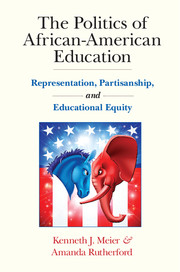Book contents
- Frontmatter
- Dedication
- Contents
- List of Figures
- List of Tables
- Preface
- 1 Representation, Partisanship, and Equality in Education
- 2 Two Myths: Separate but Equal and Nonpartisan Education
- 3 The Politics of African- American School Board Representation: Partisanship, Structure, and Resources
- 4 Race and Street- Level Bureaucrats: With a Little Help from My Friends
- 5 Partisanship, Teacher Representation, and Access to Education Opportunities
- 6 Race, Politics, and Student Learning
- 7 Can You Beat the Ovarian Lottery?
- References
- Index
2 - Two Myths: Separate but Equal and Nonpartisan Education
Published online by Cambridge University Press: 05 August 2016
- Frontmatter
- Dedication
- Contents
- List of Figures
- List of Tables
- Preface
- 1 Representation, Partisanship, and Equality in Education
- 2 Two Myths: Separate but Equal and Nonpartisan Education
- 3 The Politics of African- American School Board Representation: Partisanship, Structure, and Resources
- 4 Race and Street- Level Bureaucrats: With a Little Help from My Friends
- 5 Partisanship, Teacher Representation, and Access to Education Opportunities
- 6 Race, Politics, and Student Learning
- 7 Can You Beat the Ovarian Lottery?
- References
- Index
Summary
Underrepresented minority groups have become the majority of school-aged children in many public schools across the United States, and the last twenty years have seen a marked growth in scholarship on issues of race and education. While much of this research has referenced one or more policy changes at the federal or state level that have narrowed or exacerbated the gaps between minority and majority student achievement (e.g., Condron et al. 2013; Gaddis and Lauen 2014; Losen et al. 2015), there still remains a lack of recognition of the interplay between local politics and partisanship with issues of race and education. To be sure, the idea that politics plays a significant role in local education, while controversial, is certainly not new; a thread of literature deemed “the politics of education” has woven in and out of mainstream literature since the 1960s (Henig et al. 1999; Howell 2005; Portz, Stein, and Jones 1999; Rich 1996). Yet, as we will point out later in this chapter and throughout the remainder of the book, much of this research focuses on interest groups, unions, and internal board politics but often ignores the direct, explicit influence of partisan politics.
This chapter provides a brief overview of the development of African-American education in the United States over the past two hundred years. While a much deeper level of historical analysis may be found elsewhere (Kluger 2011; Spring 1994), the noteworthy events reviewed here will help to set the larger research of this book in context. This history is then overlaid with the development of school boards and the argument that local partisanship and political parties play a significant role in shaping school district policies that, subsequently, can determine the extent to which equal educational opportunities exist for majority and minority student groups.
Two considerations should be noted regarding the past and present states of access to education in the United States. First, racial tensions have not been unique to one portion of the United States. While these tensions were more pronounced and produced acute conflict in southern states, in no state has racial tension in education been entirely avoided. Further, racial inequities are not confined to the United States as a country. Different paths of race relations in countries around the world have produced situations in which populations have been divided into haves (social elites) and have-nots (minority groups of many kinds including recent immigrants).
- Type
- Chapter
- Information
- The Politics of African-American EducationRepresentation, Partisanship, and Educational Equity, pp. 15 - 37Publisher: Cambridge University PressPrint publication year: 2016

